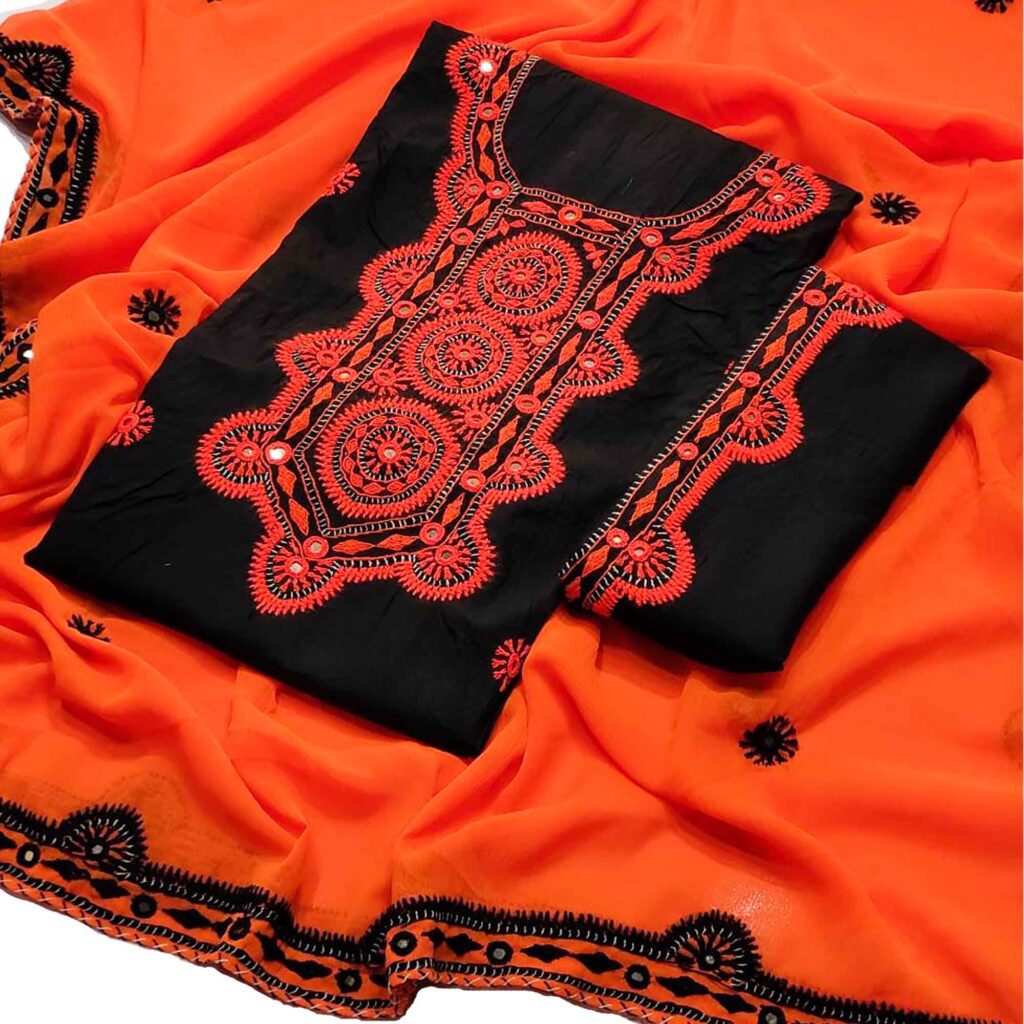Sindhi Tradition
TRADITIONAL TEXTILES OF SINDH
Sindhi Dresses are evidence of the vibrant cultural heritage of the Sindhi community. These costumes exhibit the very best of Sindhi heritage and customs with their elaborate designs, vibrant colours, and excellent craftsmanship. In this article, we explore the fascinating world of Sindhi dresses for ladies, , praising the craftsmanship, and appreciating their significance in modern culture.

- Needlework Embroidery & Mirror Work: A Classic Tradition
In Sindhi Dresses Needlework embroidery has a special role, and its methods have been handed down through the years. The complex use of needles and threads to produce beautiful motifs on fabric is a classic method of decoration. A prized talent among Sindhi artisans, needlework embroidery is recognized for its beautiful workmanship and accuracy. It also known as “Sindhi Birth” means Sindhi Embroidery.
In Sindhi Dresses, most famous and demanding fashion is Hand Needle work embroidery work and Women’s Shirts, Kurtas, Sindhi Chaadars, (Shawl) Sindhi, Scarf, Sindhi Koti, and Hand Embroidered Shalwars (Trouser) are used by the women, these types of stuff beautifully elaborate threadwork, mirror work, and beaded and are made from a variety of materials, including cotton and silk. Typical embroidery designs frequently use floral, peacock, and geometric themes. On exceptional events, festivals, and weddings, Sindhis wear embroidered kurtas, showcasing the region’s rich creative legacy.
Types Sindhi Embroideries used in Sindhi Dresses
- Hurmich
- Mirror
- Flower Motif
- Squire Chain
- Couching
- Cross Stitch
- Button Hole Stitch
- GAJJ (Craft Piece)
 A sort of bodice linked to the remainder of the garment used by Sindhi women is represented by this particular handmade item. The portion of a garment above the waist that covers the chest and shoulders is called the bodice. In Sindh, bodices are exquisitely embroidered using a variety of stitches and embellishment techniques. The Sindhi word for them is GIICH. Women are believed to feel proud when they wear a finely made GIICHI. They are constructed more skillfully and are referred to as chola when worn for weddings. They have ‘heaped’ double buttonholes and open and square chain stitches. A meticulous grid covers the entire chest area of the GIICHI as decoration. The unusual jat stitching style served as inspiration for the linear layout.
A sort of bodice linked to the remainder of the garment used by Sindhi women is represented by this particular handmade item. The portion of a garment above the waist that covers the chest and shoulders is called the bodice. In Sindh, bodices are exquisitely embroidered using a variety of stitches and embellishment techniques. The Sindhi word for them is GIICH. Women are believed to feel proud when they wear a finely made GIICHI. They are constructed more skillfully and are referred to as chola when worn for weddings. They have ‘heaped’ double buttonholes and open and square chain stitches. A meticulous grid covers the entire chest area of the GIICHI as decoration. The unusual jat stitching style served as inspiration for the linear layout.
- Patchwork: It is a technique in which different fabrics are cut into different shapes and sizes and sewn together by hand or machine, but most often with thread and a needle.
- Appliqué Wrok: Fabric is cut into intricate shapes or patterns, which are then sewn onto a piece of fabric to enhance its attractiveness, Applique work one of the beautiful art.
- Mirror Work: The art of mirror work has been practised in Sindh from ancient times, giving it significant significance and symbolism. Pakko, which means “strong,” is the name of the needlework that supports the mirror. The embroidery is incredibly sturdy and tightly grasps the weight of the mirror. The use of mirrors and their symbolic meanings varies greatly. The idea that mirror work reflects and repels the evil eye is one of the oldest symbolisms for mirror work, hence Sindhis often include mirrors into their clothing, hats, bags, and other objects in an effort to shield their loved ones from harm. Sindh is largely made up of deserts, mirror work, particularly in Sindhi work, reflects, making lost items easier to find. With the aid of reflection, an object can also be seen from a distance.
- Ajrak: The Beauty of Naturally Dyed and Block-Printed Fabric:

Ajrak fabric also known as Sindhi dress is a distinctive textile art form that was created in Sindh and has a significant cultural impact. It is a cloth that has been block-printed with intricate geometric designs and motifs, typically in blue and red tones. Natural dyes are used to create ajrak, and finely carved wooden blocks are used in the block printing technique. Numerous items of Sindhi attire, (Sindhi Dresses) including as shawls, dupattas, and turbans, are made from ajrak fabric.
Block prints are a timeless design trend that support the notion of what we refer to as sustainable and environmentally responsible fashion. The origins of block printing in the Indian subcontinent can be traced back to the Indus Valley civilisation, where the renowned Sindhi ajrak was also made by hand and coloured. Although the fundamentals of this technology date back more than 4,000 years, it has evolved with time and is now used in commercial production. Engraved wooden blocks are used in block printing. It is the earliest, slowest, and most straightforward technique for printing on fabric. Block printing is used to create elegant outfits from fabrics including cotton, lawn, silk, and linen. The blocks are hand-engraved with little or medium-sized hand-designed motifs, and the pattern-based design is used throughout.
The dynamic and culturally significant part of the Sindhi community is its dress. The rich history and aesthetic heritage of the Sindhi people are reflected in the distinctive art forms like Ajrak, elaborate needlework, and traditional clothing. As a representation of cultural identity and aesthetic brilliance, Sindhi apparel continues to be treasured and honoured not just within the Sindhi community but also throughout the world.



